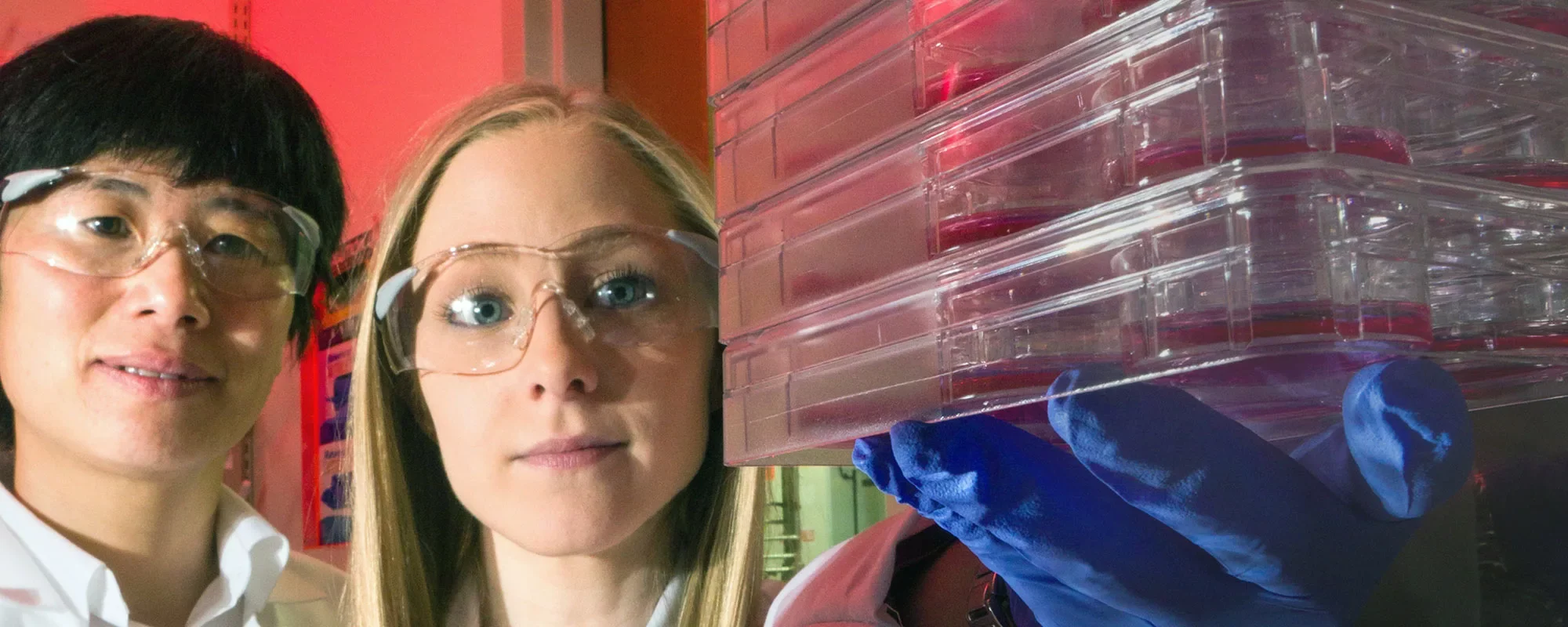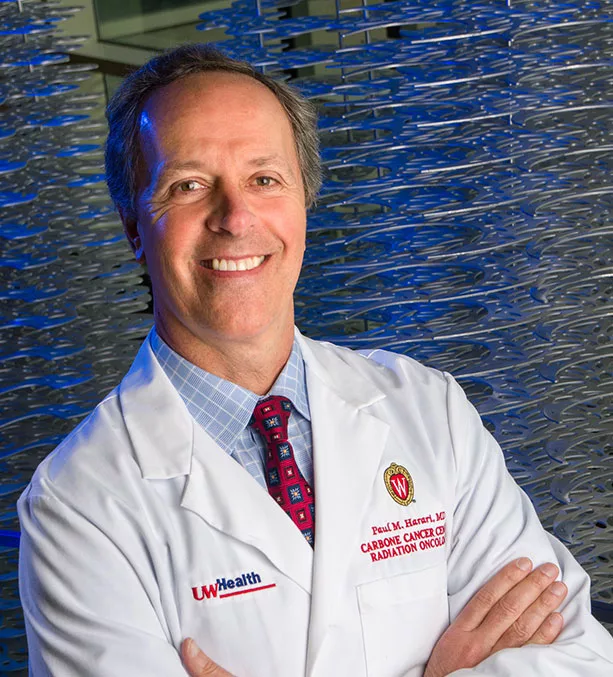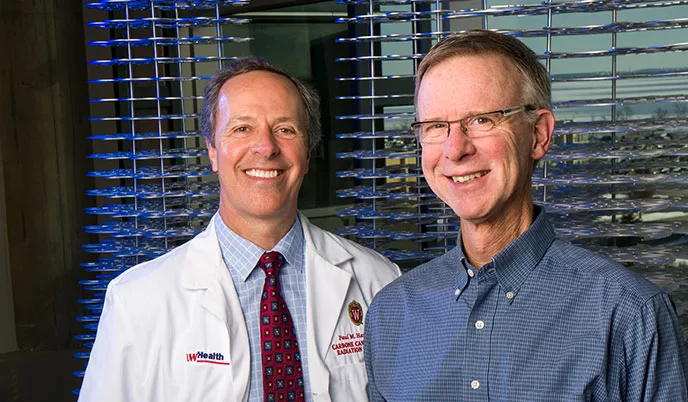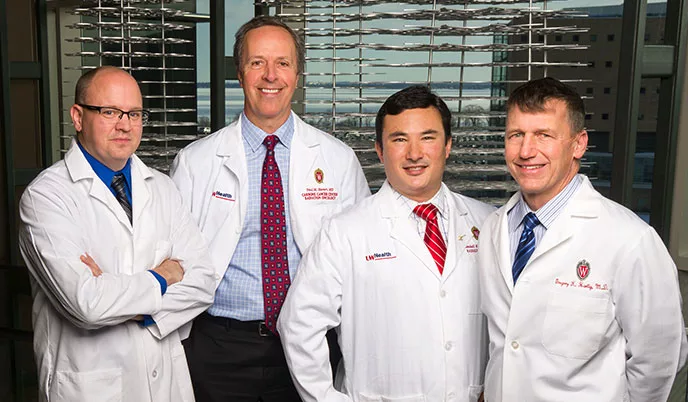New Line of Research Takes Guts
“You know, if you’re going to poop anyway, you might as well get paid for it!”

In recent years, a light often burned late in a Department of Human Oncology office at the University of Wisconsin School of Medicine and Public Health. There, you’d find Department Chair Paul Harari, MD, toiling over a project that resembled Sisyphus’s mythical task: rolling a boulder up a hill, only to have it come crashing down.

Harari’s “boulder” was the UW Carbone Cancer Center’s (UWCCC) application to earn its first Specialized Programs of Research Excellence (SPORE) grant from the National Cancer Institute (NCI). Although the UWCCC was among the nation’s first federally recognized cancer centers, it took many years to earn this top research award.
In fact, four times since convening the UW–Madison SPORE effort in 2010, Harari’s team submitted a massive proposal to the NCI for a grant in head and neck cancer (HNC) research. About 40 faculty members contributed to the proposal, with the goal of moving cutting-edge research from the laboratory into the clinical setting where it could directly benefit patients. Although the 2013 SPORE proposal ranked very highly in the nation, it just missed the NCI payline that year. The federal SPORE Program funds all or nothing, and only about 10 percent of proposals are accepted.
“It was painful to come so close and wind up with nothing,’’ says Harari, who by that point kept slippers in his office because he spent so many evenings there.
But the Wisconsin team kept pushing toward the end goal.
Gregory Hartig, MD, who shares Harari’s passion, remembers the struggle.
“I would come to the hospital to round on my patients on beautiful, sunny Saturdays, and Paul would be in his office for 12 hours,’’ recalls Hartig, a member of the SPORE team and chief of the Section of Head and Neck Surgical Oncology in the Division of Otolaryngology–Head and Neck Surgery. “I was inspired by Paul’s dedication— he simply did not give up.”

The effort finally paid off in 2016. Following an NCI review, the UW–Madison SPORE application earned an exceptionally high score, thereby winning $11 million in research funding, with an additional $3 million in UW–Madison matching funds. This funding supports four primary research projects and several innovative clinical trials to benefit HNC patients.
The SPORE grant also includes pilot project money to help the UW School of Medicine and Public Health grow its next generation of researchers, as well as support for established researchers who are interested in applying their expertise to new projects in head and neck cancer.
“These dollars will be spent on research here at UW–Madison, so it’s a wonderful opportunity for young scientists to start new projects in the field,” exclaims Hartig. “That’s one of the most exciting parts of the SPORE grant.”
Noting that head and neck cancer is a particularly cruel disease, Harari and Hartig say their patients provided their motivation to keep applying for SPORE funding. Few other types of cancer survivors wear their suffering so visibly.
“Many head and neck cancer patients wear their battle scars in public — they can lose their ability to speak, taste and swallow naturally,’’ says Harari. “We owe them a better future. While we are able to offer cutting-edge care in head and neck cancer treatment here at UW Health, it’s simply not good enough. There are still too many recurrences, too many side effects, and too many deaths.”
IMRT enabled us to tailor the dose to the tumor and reduce the damage to normal tissue.
- Paul Harari, MD
When Harari, now the Jack Fowler Professor of Human Oncology, joined the UW School of Medicine and Public Health faculty in 1990, researchers at UW–Madison and elsewhere were making great strides in reducing the collateral damage of HNC radiation treatments. For instance, T. Rockwell Mackie, PhD, emeritus professor of medical physics and human oncology, and his colleagues were developing a new technology to deliver intensity-modulated radiation therapy (IMRT), which allows radiation oncologists to sculpt the beam more precisely to the tumor. Mackie’s work led to the founding in Madison of TomoTherapy, which was purchased by Accuray in 2011.
“Before the development of IMRT, we had to shine radiation beams directly through nearby normal organs,’’ Harari recalls. “IMRT enabled us to tailor the dose to the tumor and reduce the damage to normal tissue.”
Harari hoped that one of his patients, Marshall Flax, would be a candidate for IMRT — which had been in use at UW Hospital and Clinics for only a few years when Flax’s advanced tonsil cancer was discovered by fluke in 2003. Then 50 years old, Flax went in for a tonsillectomy to reduce his snoring, but his surgeon discovered cancer of the tonsil. Next, Harari diagnosed Flax as having stage 4 cancer that had already spread to lymph nodes in his neck.
Deemed not an ideal candidate for IMRT because he had multiple tumors in both sides of his upper neck, Flax endured difficult radiation and chemotherapy treatments. Radiation left him with what he describes as “the world’s worst sunburn” in his throat, limiting his ability to swallow for several months. Struggling to consume 700 calories daily via a nasal-gastric tube, he lost 45 pounds and battled pain, fatigue and dehydration. The treatment also affected his salivary glands, and he has never fully regained his ability to taste sweet flavors.
Because Flax survived with his physical appearance intact, Harari describes him as “one of the patients who wear his scars invisibly.” Still, Flax knows his radiotherapy was a major improvement compared to treatment that was available earlier.
“I had it so much better than the people who came before me,’’ says Flax, an active member of the head and neck cancer survivor group at UW Health, where he has raised awareness about HNC, provided support, participated in fundraising efforts and encouraged patients to participate in clinical trials.
“The people who took care of me are the only reason I’m alive, and I feel personally obligated to give back,’’ he says.
Like other grateful patients, Flax wrote letters of support each time Harari’s group submitted SPORE grant applications to the NCI.
“I’m a big believer in research, and even though the gains may seem like small steps, they add up to big improvements for patients,” he shares.

Flax hopes the grant helps Harari and his team discover better measures to prevent HNC and better treatments that reduce the “collateral damage” for patients.
Incremental research advances enabled Harari and colleagues to conduct an international clinical trial, published in 2006 in the New England Journal of Medicine, that confirmed the ability of a new molecular cancer drug — cetuximab — combined with radiation to improve survival rates for HNC patients. The UW–Madison team hopes to make other major research advances through the SPORE grant to help future patients.
Harari expressed deep gratitude to his surgical colleagues on the SPORE grant — notably Hartig and Tim McCulloch, MD, professor of surgery and head of the Division of Otolaryngology–Head and Neck Surgery, who co-lead SPORE projects and provide critically important tumor specimens to the SPORE teams for research studies.
“I have worked very closely with Greg Hartig for 23 years. He is a remarkably talented HNC surgeon who brings a terrific bedside manner and great compassion to cancer patients,” says Harari.
“Since Tim McCulloch’s arrival at UW Health 10 years ago, the HNC program has further expanded, including the hiring of talented new surgeons and radiation oncologists. We also have exceptional leadership from research experts Nadine Connor (PhD) and Susan Thibeault (PhD) (both professors in the Department of Surgery), who direct the Career Enhancement and Developmental Research Programs within the SPORE grant.”
Harari believes that while technical advances in radiation and surgical treatments have improved outcomes for HNC patients to date, major additional gains will come from new findings in UW–Madison molecular biology laboratories. They star in three of the four SPORE projects at the UWCCC.
“We are so much better at treating these cancers in 2017 than we were in 2003, but we have been waiting for molecular biology advances to be able to significantly impact cure rates,’’ Harari says.
“That is what the SPORE grant is all about. We are finally unleashing 25 years of molecular biology research to better fight individual cancers.”
UW School of Medicine and Public Health Dean Robert Golden, MD, shares Harari’s enthusiasm.
“This exciting new SPORE grant highlights the unique strengths of the UW School of Medicine and Public Health , where science that bridges multiple departments and scientific disciplines moves basic molecular discovery into meaningful clinical advances,” says Golden. “We are grateful to Paul Harari for his remarkable leadership, and to the entire team of all-star scientists, who will move this work from the molecule to the patient as they develop treatments.”
Harari believes the UWCCC has the talent to put together other successful SPORE proposals related to several major cancer types. He hopes to share what the head and neck cancer team has learned to help other colleagues reach that bar.
“A SPORE grant offers a fantastic opportunity to positively impact the next generation of cancer researchers so their work can truly benefit cancer patients.”
Wisconsin’s first-ever Specialized Programs of Research Excellence (SPORE) grant features four major scientific projects designed to bring research from the lab into clinical trials to create better treatments for patients who have head and neck cancer (HNC).
Underlying and supporting the work of all four projects are the Statistical Core, led by Menggang Yu, PhD, professor, Department of Biostatistics and Medical Informatics, and the Pathology Core, led by David Yang, MD, associate professor, and Ricardo Lloyd, MD ’75, PhD ’75, professor, Department of Pathology and Laboratory Medicine, University of Wisconsin School of Medicine and Public Health.
“The work of the Pathology and Statistical Cores is critical to the SPORE grant’s success,” says Paul Harari, MD, chair of the UW School of Medicine and Public Health Department of Human Oncology and principal investigator of the SPORE grant at the UW Carbone Cancer Center (UWCCC). “Wisconsin is known for the depth of its basic science research, and these projects—which pair basic science research with clinicians—will bring that research from the lab to our patients.” The four major SPORE projects and their basic and clinical science research leaders are:
Paul Lambert, PhD, the Howard Temin Chair of Oncology and director, McArdle Laboratory for Cancer Research, will lead this project, along with surgeon Timothy McCulloch, MD, head, Division of Otolaryngology-Head and Neck Surgery, Department of Surgery. Lambert — an international expert in the study of the human papillomavirus, which causes certain HNC cancers—created transgenic mouse models that enable better understanding of mutations that contribute to HNC. They plan to identify new targets for therapy and biomarkers that better predict outcomes for cancer patients.
Harari and Greg Hartig, MD, professor, Department of Surgery, will use the “Wisconsin molecule” developed by Jamey Weichert, PhD, associate professor, Department of Radiology, and colleagues, in a clinical trial. Known as CLR1404, the molecule is selectively taken up by cancer cells and can carry with it a payload of targeted radiation. The work begins in mice with HNC tumors. The scientists have designed a Phase 1 clinical trial for HNC patients in hopes that the targeted molecule will allow them to reduce the dose of external beam radiation and thereby save more healthy tissue.
Alan Rapraeger, PhD, professor, Department of Human Oncology, and Justine Bruce, MD, assistant professor, Department of Medicine, will seek to inhibit receptors called syndecans. These complex receptors are found in the membranes of HNC cells, where they organize groups of receptors into signaling hubs that promote cancer cell growth. Rapraeger has developed peptides (synstatins) that interrupt syndecans and thereby slow tumor growth. The team will be testing these peptides in mice, and if successful, they hope human clinical trials will follow.
Deric Wheeler, PhD ’04, associate professor, Department of Human Oncology, has shown that a cellular receptor called AXL may play a significant role in why HNC cells become resistant to the drug cetuximab. He will examine whether inhibiting AXL in mice will make HNC tumors more sensitive to the drug. Wheeler and project co-leader Randall Kimple, MD, PhD, assistant professor, Department of Human Oncology, will direct a clinical trial in patients with cetuximab-resistant HNC.
The SPORE grant will solicit pilot HNC research proposals, with the goal of funding promising new projects by junior faculty and new research by established scientists. “We want to help UW–Madison cancer researchers join in our collective pursuit of more effective treatments for HNC patients,’’ Harari says.